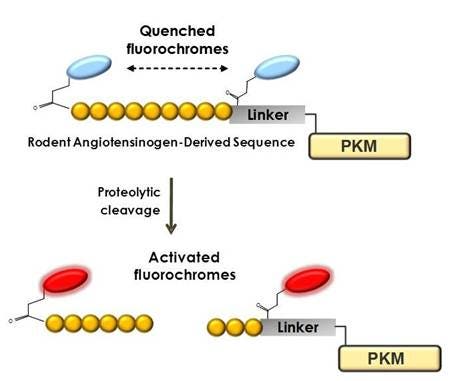
Overview
Renin is a peptide hormone secreted by the kidney from granular cells of the juxtaglomerular apparatus. This secretion is the first step in a cascade of events that leads to increased blood pressure. Renin is upregulated in response to sympathetic nervous system activity, a decrease in arterial blood pressure, or a decrease in plasma sodium chloride levels. Specifically, renin upregulation leads to increased blood pressure by cleaving angiotensinogen (produced in the liver) to yield angiotensin I, which is further converted to angiotensin II. Angiotensin II constricts blood vessels, increases aldosterone secretion from the adrenals, and stimulates a thirst reflex.
IVISense™ Renin 680 FAST (formerly ReninSense) is a renin activatable fluorescent probe that is optically silent upon injection and produces fluorescent signal after cleavage by renin produced in the kidneys. The Renin-Angiotensin System (RAS) is the hormone system involved in regulating blood pressure and fluid balance in the body. IVISense Renin 680 FAST may be used to monitor abnormal RAS function, progression of disease, and the efficacy of therapeutic treatment in mouse models of hypertension and cardiovascular disease and some neurological diseases. Specifically, IVISense Renin 680 FAST probe is recognized and activated by rodent forms of renin in preclinical animal models.
IVISense Renin 680 FAST is a member of a family of the activatable fluorescent imaging probes comprising a novel architecture, termed F.A.S.T. (Fluorescent Activatable Sensor Technology). These probes confer an improved pharmacokinetic profile with a broader range of early imaging time points. This architecture also offers higher target specific signal with reduced background.

Figure 1: Description and mechanism of IVISense Renin 680 FAST
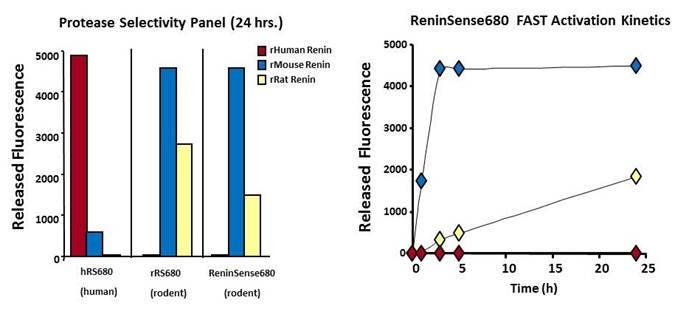
Figure 2: IVISense Renin 680 FAST (formerly ReninSense) was tested in vitro for cleavage activity by species specific renin. Species-specific substrate sequences (hRS680, rRS680) were derived from angiotensinogen. These substrates were highly specific for cleavage by their respective renin. As shown in the left panel, IVISense Renin 680 FAST is a highly specific substrate for rodent renin.
Products and catalog numbers
| Product | Catalog Number | Ex/Em wavelength (nm) | Molecular weight (g/mol) | Validated Experiments | Applications |
|---|---|---|---|---|---|
| IVISense Renin 680 FAST | NEV11079 | 675/693 | 43,000 | In vivo/Ex vivo Flow cytometry In vitro microscopy |
Oncology Renal Hypertension Neurological diseases |
Using IVISense Renin 680 FAST probe for in vivo/ex vivo studies
The recommended procedure for in vivo imaging with IVISense Renin 680 FAST is administration via intravenous injection and imaging 24 hours post injection. Earlier and later time points may be appropriate for some disease models, and the optimal imaging time point for any application should be determined empirically.
View a more-complete imaging protocol.
| Product | Route of Injection | Mouse Dose (25 g) | Rat Dose (250 g) | Blood t 1/2 | Tissue t 1/2 | Optimal imaging time | Optimal Re-injection Time (complete clearance) | Route of Metabolism/ background tissue | FMT and IVIS settings |
|---|---|---|---|---|---|---|---|---|---|
| IVISense Renin 680 FAST | IV | 2 nmol | 6-20 nmol | 7 h | 48 h |
24 (12-24) h |
4 d | Kidney, lung, liver | FMT 680/700 IVIS 675/720 |
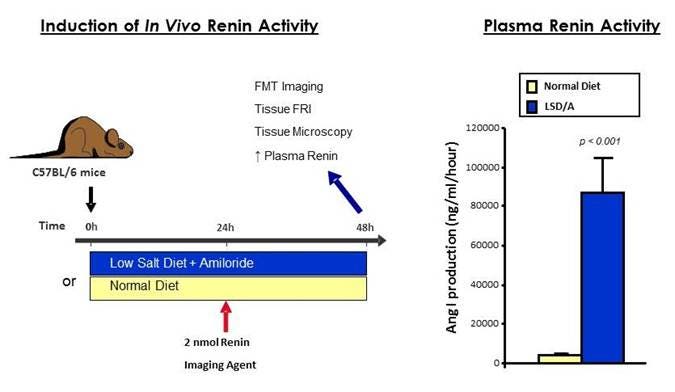
Figure 3A: Induction of Renin Activity in Mice. Mice were fed a low salt diet with amiloride (LSD/A) or normal diet to induce upregulation of renin activity (left panel). Upregulation is confirmed by detecting high renin activity in plasma (right panel).
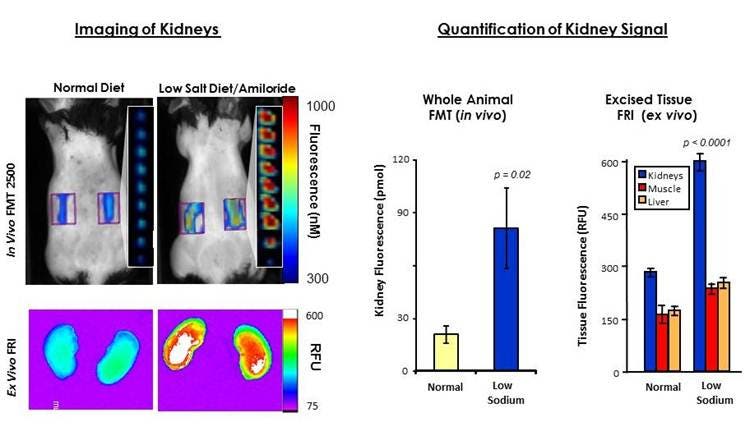
Figure 3B: Non-invasive imaging of kidneys from mice treated as shown in Figure 3A. Using fluorescence molecular tomography and IVISense Renin 680 FAST probe, upregulation of renin can be detected in LSD/A-induced mice (left panel). This was confirmed by ex vivo assessment of the tissue (right panel).
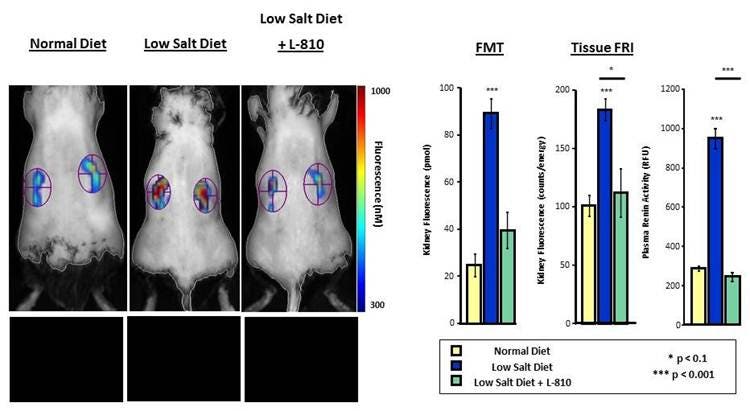
Figure 4: Renin imaging with IVISense Renin 680 FAST was validated using a selective renin inhibitor (L-810). As shown in the above panels, IVISense Renin 680 FAST signal was reduced in the presence of the renin inhibitor.
Ex Vivo Imaging
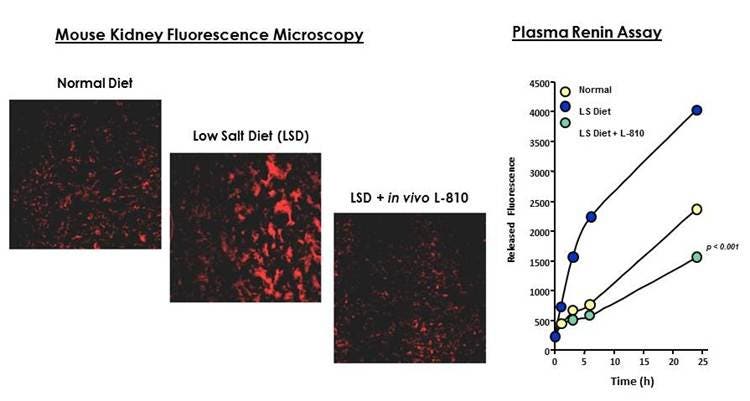
Figure 5: Ex vivo validation of IVISense Renin 680 FAST selectivity. IVISense Renin 680 FAST detects increased renin activity in tissue and plasma samples from mice fed on a low salt diet (LSD) and is selectivity inhibited by the renin inhibitor, L-810.
Frozen Tissue Protocol
We have validated IVISense Renin 680 FAST for use with frozen tissue samples (kidney tissue). Here is a brief protocol with a recommended concentration of probe to use:
- Freeze tissue (without probe) and section 5-10 µm by cryostat To increase kidney renin activity, C57BL/6 can be placed on a low salt diet for 2-3 days prior to harvest of kidneys.
- Incubate with 1 µM IVISense Renin 680 FAST at 37 ºC for 3 hours.
- Wash 1x with PBS.
- Mount with anti-fade reagent.
- Fluorescence microscopy filter: Cy5.5
FAQs
Q. Can I use IVISense Renin 680 FAST in humans?
A. No, IVISense Renin 680 FAST is intended for animal research use only not intended for use in diagnostic procedures and is not intended for use in humans.
Q. Where do I draw the blood and can the blood samples be stored and read at a later date?
A. The blood can be drawn however you are comfortable. Our experts do not recommend storing the samples because it can affect the fluorescent signal.
For research use only. Not for use in diagnostic procedures.
The information provided above is solely for informational and research purposes only. Revvity assumes no liability or responsibility for any injuries, losses, or damages resulting from the use or misuse of the provided information, and Revvity assumes no liability for any outcomes resulting from the use or misuse of any recommendations. The information is provided on an "as is" basis without warranties of any kind. Users are responsible for determining the suitability of any recommendations for the user’s particular research. Any recommendations provided by Revvity should not be considered a substitute for a user’s own professional judgment. Users are solely responsible for complying with all relevant laws, regulations, and institutional animal care and use committee (IACUC) guidelines in their use of the information provided




























